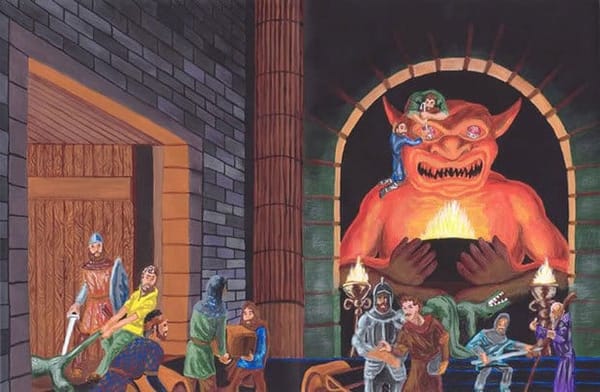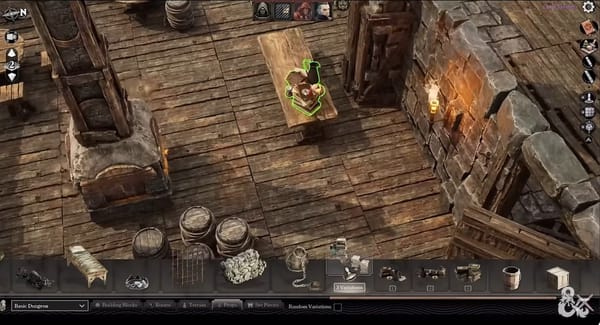Binary Pass/Fail Rolls are Fine, Actually

As the tabletop space has evolved from its wargaming routes, one of the more commonly discussed and designed around challenges has been using dice to resolve situations. While D&D immortalized the now iconic D20, still other resolution mechanics continued to pop up; RuneQuest with its D100 based system, FUDGE and later FATE with the eponymous FUDGE dice, Shadowrun and World of Darkness with their dice pool systems (d6s and d10s respectively) and many more that would be too cumbersome to list here.
Something that many of these systems share in common though is a rather binary approach to the rolls themselves; you either succeed at what you're trying to do or you don't, with no options in between. As adventure design became more linear and more focused on storytelling (what we would call the "trad" style of play) this began to irk players, GMs, and game designers alike, like an itch you just couldn't scratch.
And so a whole new era of dice mechanics was born that would allow for a spectrum of success or failure. While D&D would remain stuck in its binary pass/fail ways, other games like Apocalypse World and Blades in the Dark would popularize experimenting with things like success at a cost, failure with complications, and other such styles of resolution.
I've actually historically been a pretty big fan of this resolution style. It fit the kind of games I was playing (mainly linear, trad games), allowed the dice to lead to more interesting stories and also meant that players were a bit less frustrated when the dice didn't go their way.

The more I've thought about this though, the more I've realized that my dissatisfaction with binary pass/fail mechanics was actually more symptomatic of a deeper issue. That issue was the entire approach to modern module/adventure design in popular trad games like 5th Edition D&D or Pathfinder 2nd Edition. Let me explain.
Adventure design in the world's most popular roleplaying game (and its many derivatives) has become pretty linear over the past 35-40 years or so (most people place the blame for this squarely on the Dragonlance series of modules for 2nd edition AD&D). During this time of increasingly linear adventure design, 3rd edition D&D also introduced the idea of the Difficulty Class (0r DC for short), essentially a target number you have to hit to overcome an obstacle..
What this has combined into is a series of linear challenges where the players HAVE to be able to overcome certain obstacles in order to progress through the module. And their ability to do so is based on a pretty swingy dice roll, the D20, where you have a 5% chance to roll any given number on its polyhedral surface. This leads to a lot of feel bad moments for players and GMs alike; what am I supposed to do if none of my players can pick the locked door successfully, or they can't find the hidden key, or they can't jump over the broken bridge? As a player it feels especially bad when you fail to pick the lock of the door that is clearly the intended way forward!
Let's go into a specific example from a published Pathfinder 2E adventure; Punks in a Powderkeg is the first of 3 books in the Outlaws of Alkenstar adventure path, designed to take a party of 4 adventurers from level 1 to level 10. It's a steampunk adventure focused on a seedy criminal underbelly and a deadly new explosive; it's pretty cool and has some neat set pieces in it! It also has, in classic Paizo fashion, some real "what the fuck" moments in it.

Take the map above of the Wailing Scrapyard. The players are supposed to enter the scrapyard after successfully robbing the bank of a corrupt business mogul. The scrapyard represents their escape route as they are chased by the cops, with the end destination being a clean getaway through the sewers of the city. About halfway through the scrapyard, the players get confronted with the challenge at B7; a ghostly machine spirit gone berserk and an airship that needs to be moved.
Defeating the machine spirit either requires some pretty high for a level 1 party skill checks (in either Religion or Engineering Lore) or for them to just beat it to death (while it belches noxious smoke slowly killing them every turn). Only once the machine spirit has been quelled can they then try to re-activate the airship engine in order to move it out of the way, requiring either a Crafting or Engineering Lore check.
Not only is this a pretty challenging hazard by PF2E's own rules (a level 3 hazard for a level 1 party), the skill checks after are pretty high too (DC20 for a successful crafting check) and the party has no other way forward in the module. Not to mention they have a time crunch (the cops will eventually catch up with them) this feels like disastrous design in a largely pass/fail system (technically PF2E has degrees of success/failure with its crit system but it's not super relevant here). The only reason my party passed this obstacle with ease was because of a lucky crit that immediately exorcised the ghost, which made this trivial for them; but it could've just as easily swung the other way and been a source of huge frustration.
This simply wasn't a problem in the 'good old days' (I say very sarcastically) of the dungeon crawl. Consider the map of the Caves of Chaos, the dungeon found within the legendary Basic module B2-Keep on the Borderlands.

There's a lot going on here that you need to parse through at first glance. The caves are divided into various sub-sections based on which monsters inhabit which section; many of the sections aren't even directly connected, or may only be connected via hidden entrances the players need to discover. But the important part here is giving players options; if they fail to discover a secret door, or feel they have exhausted one section of the caves for now, they can simply go explore and find a new entrance, or come back later if they discover new information, etc. The inherent non-linearity and sandbox approach means that failing to accomplish something doesn't suddenly derail the entire adventure for them.
Going back to the example of the locked door, failing to pick a lock here simply means you aren't going through that door; you'll just have to go somewhere else instead! It's no longer an adventure fail state, and that means that the binary nature of pass/fail can be used to its full extent, rather than as a frustrating mechanic from antiquity that needs to be designed around.
In conclusion; if you are doing anything remotely sandbox, binary pass/fail works just fine for your resolution mechanics! If you are doing linear trad play, you may want to try degrees of success/failure, but consider this; if your players HAVE to be able to overcome an obstacle to see the rest of the story you planned, why are you having them roll at all? And if you're not having them roll at all, are we still playing a roleplaying game or are we just doing collaborative improv with miniatures and maps?





